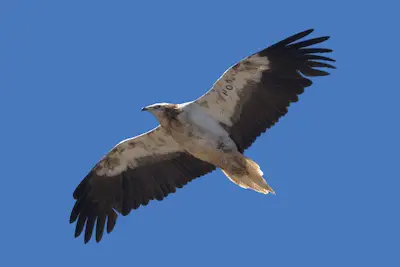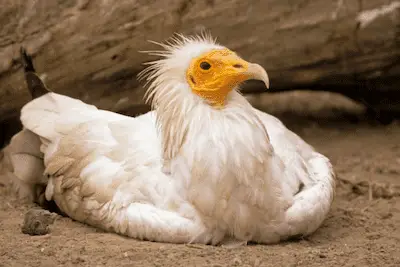Egyptian Vulture
(Neophron percnopterus)
Once revered as a sacred bird in ancient Egypt, the Egyptian Vulture is now a rare and threatened raptor species in most parts of its range.

The European population has shrunk to around 2,000 pairs, most of which are currently found in Spain.
And since the remaining populations in other parts of Europe are small and disjointed, this makes them extremely vulnerable to threats.
Fortunately however, the Spanish population of the Egyptian Vulture is stable, providing hope that conservation efforts will be able to secure the future of this fascinating vulture in Europe.
Egyptian Vulture facts
The Egyptian Vulture is a small vulture that used to be common large parts of Europe, but has become extinct, or exceedingly rare in recent decades.
Egyptian Vulture Size
The Egyptian Vulture is a relatively small vulture that is significantly smaller than all other European vulture species.
- Wingspan: 156-170 cm
- Length: 59-70 cm
- Weight: 1,800-2,400 g
While there is a size difference between the sexes, this is not as apparent as with other raptors in Europe.
Appearance
With its striking combination of white body with black wing feathers, the Egyptian Vulture resembles a White Stork, but without the long neck and long legs. It is also significantly smaller than either a stork or other vultures, which makes it relatively easy to identify.

Sexual dimorphism
Similar to other raptors, female Egyptian Vultures are larger than males, but otherwise there are no observable differences.
Lifespan
A maximum age of 40 years has been recorded in captivity, but it is not known how long the Egyptian Vulture lives in the wild.
Scientific name and taxonomy
The scientific name of the Egyptian Vulture is Neophron percnopterus. There are 3 known subspecies in the world, 2 of which occur in Europe: N. p. majorensis (in the Canary Islands), and N. p. percnopterus (everywhere else in Europe). It is taxonomically distinct from most other vulture species, and its closest relative is the Bearded Vulture (Gypaetus barbatus).
Egyptian Vulture distribution
The European population of the Egyptian Vulture is found in southern Europe, with the largest population in Spain, and minor populations in Portugal, France, and Greece. Outside of Europe, it breeds in Turkey and eastwards from the Middle East to Central Asia. In addition to this, it also breeds in many African countries.
Egyptian Vulture habitat
Prefers arid and semi-arid landscapes with woods and bushland. It soars over open countryside in search of carrion, but requires cliffs and canyons for nesting. In some countries it also occurs close to human settlements, and frequents garbage dumps in search of food.
Egyptian Vulture population size
The European population of Egyptian Vultures is estimated to be around 2,000 paris, with more than 1,500 of these found in Spain. The closest population outside of Europe is in Turkey, which is estimated to have more than 1,000 pairs.
Egyptian Vulture behavior
The Egyptian Vulture is most often observed slowly soaring at a low altitude while scouring the landscape for food, as well as congregating at animal carcasses together with other vultures.
Feeding and diet
The main food source is carrion, and it is often found feeding at the same carcasses as larger vulture species, such as the Eurasian Griffon Vulture (Gyps fulvus), or the Cinereous Vulture (Aegypius monachus).
However, unlike these larger vultures, it is unable to open up large animal carcasses with its relatively small beak, and usually waits until the larger vultures are finished eating before it starts feeding on a carcass.
Breeding
Builds its nest in cliffs, and is usually a solitary nester. The female lays 2 eggs, which are incubated up to 6 weeks, and the young vultures stay in the nest for up to 85 days. Unlike many other European vultures, the Egyptian Vulture often manages to raise two chicks per brood.
Migration
The majority of the European population of the Egyptian Vulture is strictly migratory, with only a handful of birds remaining in Europe during the winter. Adults migrate south in September, and return in February or March.
Juvenile birds often take much longer before they come back from their winter quarters, and sometimes return as late as June. Unlike the mainland population of Egyptian Vultures, the population in the Canary Islands is sedentary.
Egyptian Vulture conservation status
While the Egyptian Vulture was previously common in many countries, it has now become rare and threatened in most parts of its range, and is currently classified as “Endangered” by BirdLife International.
Threats
As a carrion eater, the main threat to Egyptian Vultures is illegal poisoning due to poisoned baits put out for other species, including wolves and other raptors.
In addition to this, the Egyptian Vulture has also suffered from improved trash disposal methods used by humans, since human waste and garbage used to be a major food source for Egyptian Vultures in the past.
Electrocution on power poles or collision with wind turbines is another serious threat to these vultures.
